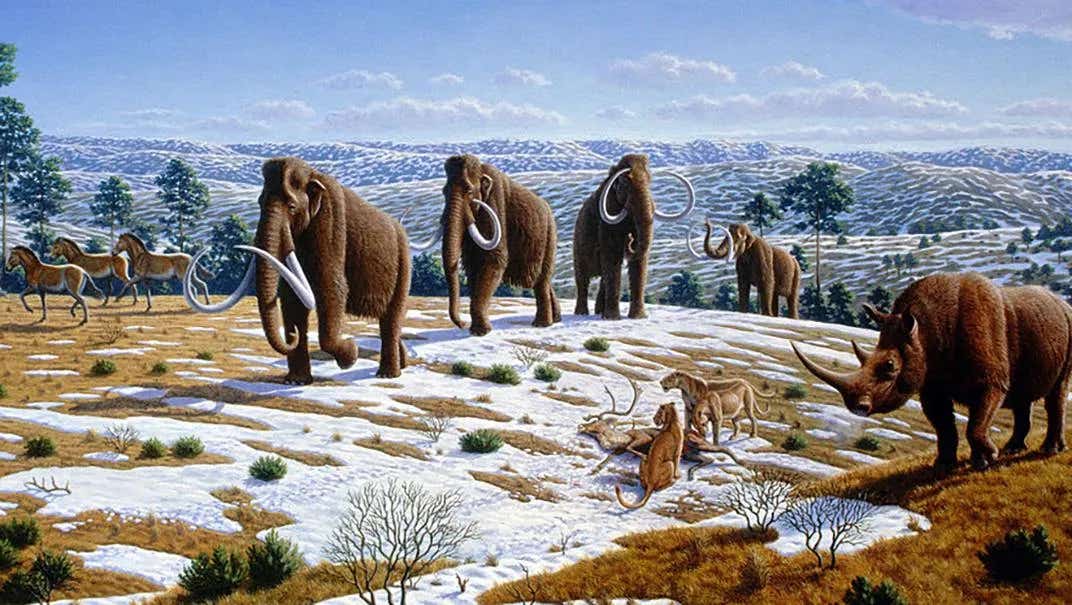The Great Die-Off: Why North American mammals went extinct 50,000 years ago
At the end of the Last Ice Age, most of this megafauna vanished. The reasons behind this mass extinction remain a subject of heated debate

At the end of the Last Ice Age, most of this megafauna vanished. The reasons behind this mass extinction remain a subject of heated debate among scientists. (CREDIT: Denis-Art/iStock)
Around 50,000 years ago, North America was teeming with megafauna. Mammoths roamed the tundra, while towering mastodons, saber-toothed tigers, and enormous wolves inhabited the forests. Bison and unusually tall camels traveled in herds, and giant beavers thrived in lakes and ponds. Immense ground sloths, each weighing over 1,000 kg, populated the regions east of the Rocky Mountains.
Then, at the end of the Last Ice Age, most of this megafauna vanished. The reasons behind this mass extinction remain a subject of heated debate among scientists. Some researchers argue that the arrival of humans played a crucial role. These humans may have hunted the megafauna, altered their habitats, or competed with them for food.
Others contend that climate change was the primary driver, with the Earth's transition from glacial to warmer conditions creating environments that megafauna couldn't adapt to fast enough. This debate remains unresolved, with neither side providing conclusive evidence to rule out the other.
The Complexity of Ice Age Extinction
Despite extensive research, the mystery of North America's Ice Age megafauna extinction remains unsolved. Current evidence is insufficient to definitively support one theory over another. Some scientists even propose other potential causes, such as disease, comet impacts, or a combination of factors.
One of the primary challenges in resolving this mystery is the fragmented and often unidentifiable state of many megafaunal bones. While some archaeological sites preserve these remains well, many bones are degraded by processes like exposure, abrasion, and biomolecular decay.
These preservation challenges leave critical gaps in our understanding of where specific megafaunal species lived, the exact timing of their disappearance, and their responses to human arrival and environmental changes during the Late Pleistocene.
Modern Technology to the Rescue
To address these gaps, researchers are turning to advanced biomolecular methods. A significant effort involves examining the extensive collections of the Smithsonian National Museum of Natural History in Washington, DC.
Related Stories:
This museum holds a vast array of animal bones from numerous archaeological excavations conducted over the past century. However, many of these bones are heavily fragmented and have remained largely unstudied until now.
Recent advancements in biomolecular archaeology have enabled researchers to extract valuable information from these old bones. One such technique is Zooarchaeology by Mass Spectrometry (ZooMS). This method capitalizes on the fact that while most proteins degrade quickly after an animal's death, some, like bone collagen, can persist for long periods.
Collagen sequences differ subtly between different animal groups and species, providing a molecular barcode that can help identify otherwise unidentifiable bone fragments. By extracting and analyzing collagen protein segments from tiny quantities of bone, ZooMS can identify species with remarkable precision.
A pilot study aimed to determine whether the Smithsonian's collections preserved enough collagen for useful analysis. Given the age of the bones and the conditions under which they were excavated and stored, the outcome was uncertain. The bones came from five archaeological sites in Colorado, dating from the Late Pleistocene to the earliest Holocene (approximately 13,000 to 10,000 years ago).
The earliest excavations occurred in 1934, with the latest in 1981. Many of the bones were highly fragmented and weathered, making traditional identification methods ineffective.
The study yielded surprising results. Despite the age and condition of the bones, 80% of the sampled fragments contained sufficient collagen for ZooMS analysis, with 73% identifiable to the genus level. The taxa identified included Bison, Mammuthus (mammoths), Camelidae (camels), and possibly Mammut (mastodons). Some specimens could only be assigned to broader taxonomic groups due to the lack of comprehensive ZooMS reference libraries for North American animals.
Implications for Museum Collections
These findings have significant implications for museum collections. The fragmented and unidentifiable bones that make up much of the megafaunal record can now provide valuable data, thanks to ZooMS. This technique reveals the rich information hidden in neglected specimens that have received little attention from researchers or visitors for decades.
ZooMS also offers a promising tool for addressing longstanding questions about megafaunal extinctions. By enabling the analysis of fragmented bone material, this method can provide new data to help understand when, where, and how these animals disappeared. ZooMS is a relatively easy, rapid, and cost-effective way to extract information from long-ago excavated sites.
The study underscores the importance of preserving archaeological collections. In times of funding constraints, less glamorous artifacts and bones may be neglected or discarded.
Yet, as this research demonstrates, old material can yield new insights when modern techniques are applied. Museums must receive adequate funding to care for and house archaeological remains over the long term, ensuring that even the most unassuming specimens can contribute to our understanding of the past.
Techniques like ZooMS allow researchers to extract valuable information from fragmented and degraded bones, providing fresh data to address long-standing debates.
By preserving and studying these collections, we can inch closer to understanding why some of the largest animals ever to roam the Earth vanished from ancient North America's landscapes.
Note: Materials provided above by the The Brighter Side of News. Content may be edited for style and length.
Like these kind of feel good stories? Get the Brighter Side of News' newsletter.
Joseph Shavit
Head Science News Writer | Communicating Innovation & Discovery
Based in Los Angeles, Joseph Shavit is an accomplished science journalist, head science news writer and co-founder at The Brighter Side of News, where he translates cutting-edge discoveries into compelling stories for a broad audience. With a strong background spanning science, business, product management, media leadership, and entrepreneurship, Joseph brings a unique perspective to science communication. His expertise allows him to uncover the intersection of technological advancements and market potential, shedding light on how groundbreaking research evolves into transformative products and industries.



